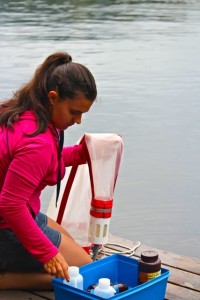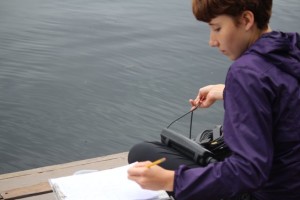Maine Lake Water Quality Testing Points to Fixes to Limit Phosphorus Increase
Maine Lakefront Property Owners: Learn To Recognize Invasive Aquatic Plants 101
August 15, 2014Out and About for the Bangor Lakes Region of Maine Aug. 21-27
August 20, 2014Maine Lake Water Quality Testing Points to Fixes to Limit Phosphorus Increase
An Intern for Lakes Environmental Association in Bridgton tests water for Gloeotrichia
by Leigh Macmillen Hayes
Last year the Lakes Environmental Association (LEA) hired a researcher to test fifteen lakes in the Sebago Lakes Region of western Maine for Gloeotrichia, “Gloeo” for short, a species of blue-green algae. Of the fifteen, six showed elevated levels of Gloeo. As a cyanobacteria, Gloeo is associated with high nutrient lakes and thus bad water quality. Therefore, it came with great surprise that this “bad” algae was found on one of the more pristine lakes in the area, Moose Pond, which stretches from Sweden through Bridgton to Denmark and sits at the base of Pleasant Mountain.
That being said, Amanda Pratt, LEA’s researcher, stated that the “numbers in Moose Pond were fifteen times lower than the highest recorded level in Maine, from Long Pond in the Belgrade Lakes Region.”
In the water, Gloeo looks like little (1/16″ diameter) round yellow-green dots about the size of a pin head suspended throughout the water column. It resembles pine pollen.
Preparing the Gloeo Sample
The discovery of Gloeo means that LEA has ramped up its testing program this summer. Pictured here are two interns who take samples from all three basins on Moose Pond, as well as 26 other lakes in the area.
They informed me that they visit the larger lakes, including Long Lake, on a bi-weekly basis because they tend to have higher use and are showing higher amounts of Gloeo. It’s still to early to know this summer if the numbers are higher or lower than last summer’s baseline, but the historic collection of data will help LEA and local lake associations make informed decisions for the bodies of water we all love.
Another LEA Intern Simultaneously Tests Dissolved Oxygen
Phosphorus trapped in sediment plays a role in the life cycle of Gloeo. Increased amounts of phosphorus cause the Gloeo colonies that enter the water column to increase dramatically.
Where does the phosphorus come from? The answer is varied — from 19th century farming and clear cut lumbering to 20th and 21st century problems such as failing septic systems, road run-off, soil erosion and the use of detergents containing phosphates.
As lakefront property owners, we need to limit the amount of phosphorus that gets into the water we love and thus into the sediment. Fixing our camp and town roads, emptying septic tanks every few years, creating narrow, curvy pathways to the water and using rain bars and other techniques, increasing the buffer and changing our habits of washing our cars and boats with soap containing phosphorus are just a few steps in the right direction.
Let’s work together to save the lakes we love. If you haven’t done so already, consider joining and supporting your local lake association.
To learn more about lakefront properties for sale on Long Lake in Naples, click on the green box above.
To learn more about lake and road associations, check out these links below.
Maine Lakefront Property Owners Benefit By Joining Lake Association
Road Associations Important to Maine Lakefront Property Owners



